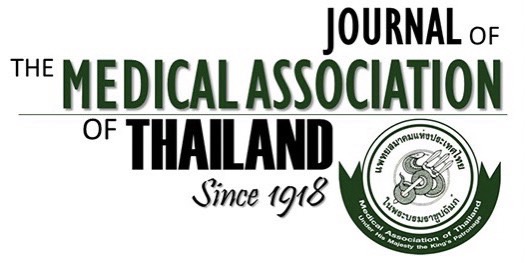Experience of Percutaneous Mechanical Mitral Commissurotomy Using Metallic Commissurotome in Patients with Mitral Stenosis at Chest Disease Institute
Boonjong Saejueng MD*, Sudaratana Tansuphaswadikul MD*, Kriengkrai Hengrussamee MD*, Wirash Kehasukcharoen MD*, Jarin Assavahanrit MD*, Anek Kanoksin MD*
Affiliation : * Cardiac Unit, Chest Disease Institute, Nonthaburi
Background : Percutaneous metallic mitral commissurotomy (PMMC) has been accepted as an alternative to
the traditional balloon technique. The advantage of the metallic commissurotome is that it is designed for
several reuse and resterization and it is an interesting tool as seen by the authors.
Objective : To evaluate the efficacy and safety of PMMC among a wide range of patients with severe mitral
stenosis.
Material and Method: Between July 2000 and August 2003, patients with severe mitral stenosis who underwent
PMMC were enrolled. Interatrial septum was punctured under transesophageal echocardiography guidance
in all cases. Demographic data and baseline characteristics were collected. Mitral valve area (MVA) was
evaluated by echocardiography and hemodynamic parameters pre and post PMMC were compared.
Results : PMMC was performed in 304 patients with a broad range of severe mitral stenosis. Mean age was
38.7 + 10.9 years and 79% was female. Most were in functional class II (94%) and 43 patients (14%) had prior
commissurotomy. Atrial fibrillation was found in 41%. Twenty-six patients were crossed over to the Inoue
balloon technique. The rate of success was 81% in all patients (246/304) and 89% in patients when PMMC
was actually done (246/278). The MVA increased from 84 + 22 to 170 + 36 mm2 (p < 0.0001). Transvalvular
gradient decreased from 17 + 6 to 7 + 4 mmHg (p < 0.0001) and mean left atrial pressure from 26 + 7 to 15 + 6
mmHg (p < 0.0001). Separation of both commissures was found in 25% and 61% had symptom relief by a
reduction in functional class at least one level (p < 0.0001). Complications developed in 16 patients (5.3%)
including three serious events, one death caused by severe mitral regurgitation followed by emergency surgery,
another survivor after surgical repair of left ventricular free wall rupture and the last one with surgical
removal of the malfunctioned device stuck in the left atrium.
Conclusion : Results of PMMC is not as encouraging as shown in previous studies. The risk of cardiac tamponade
is minimized by interatrial septal puncture using transesophageal echocardiography (TEE) monitoring but
this technique increased the possibility of crossover. Deterioration of the metallic commissurotome after a few
procedures is demonstrated in the author’s real practice.
Keywords : Mitral stenosis, Metallic commissurotome, Percutaneous metallic mitral commissurotomy, PMMC



